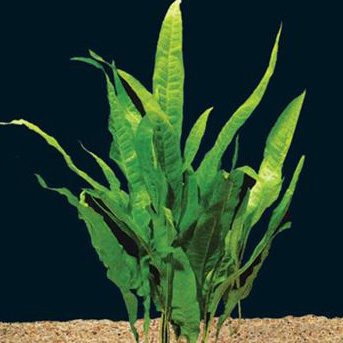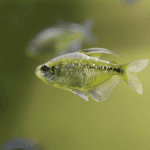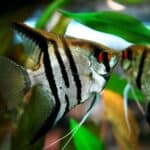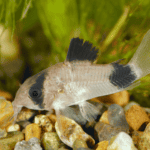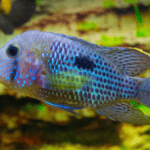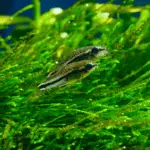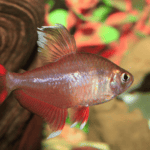Java fern, or Microsorum pteropus, has made a name for itself as a staple in the freshwater aquarium hobby. Renowned for its resilience and minimal care requirements, this aquatic plant can thrive under a wide range of conditions, making it suitable for both novice and experienced aquarists. Originating from Southeast Asia, Java fern naturally attaches to rocks and wood instead of rooting in the substrate, which adds a dynamic layer to aquascaping possibilities and mimics its natural riparian environments.
Adapting to various water parameters, Java fern requires little in the way of specialized nutrition, often finding sufficient sustenance from tank water supplemented by the waste of its inhabitants. Its propagation method is straightforward, often leading to new plants forming on the tips of its leaves, which can be detached and encouraged to grow independently. For aquarists looking to delve into the world of planted tanks, Java fern serves as an excellent starting point.
Key Takeaways
- Java fern is a highly adaptable plant suitable for aquarists of all levels.
- It requires minimal maintenance and thrives in a variety of water conditions.
- Propagation is simple, with new plants easily grown from leaf tip starters.
Understanding Java Fern
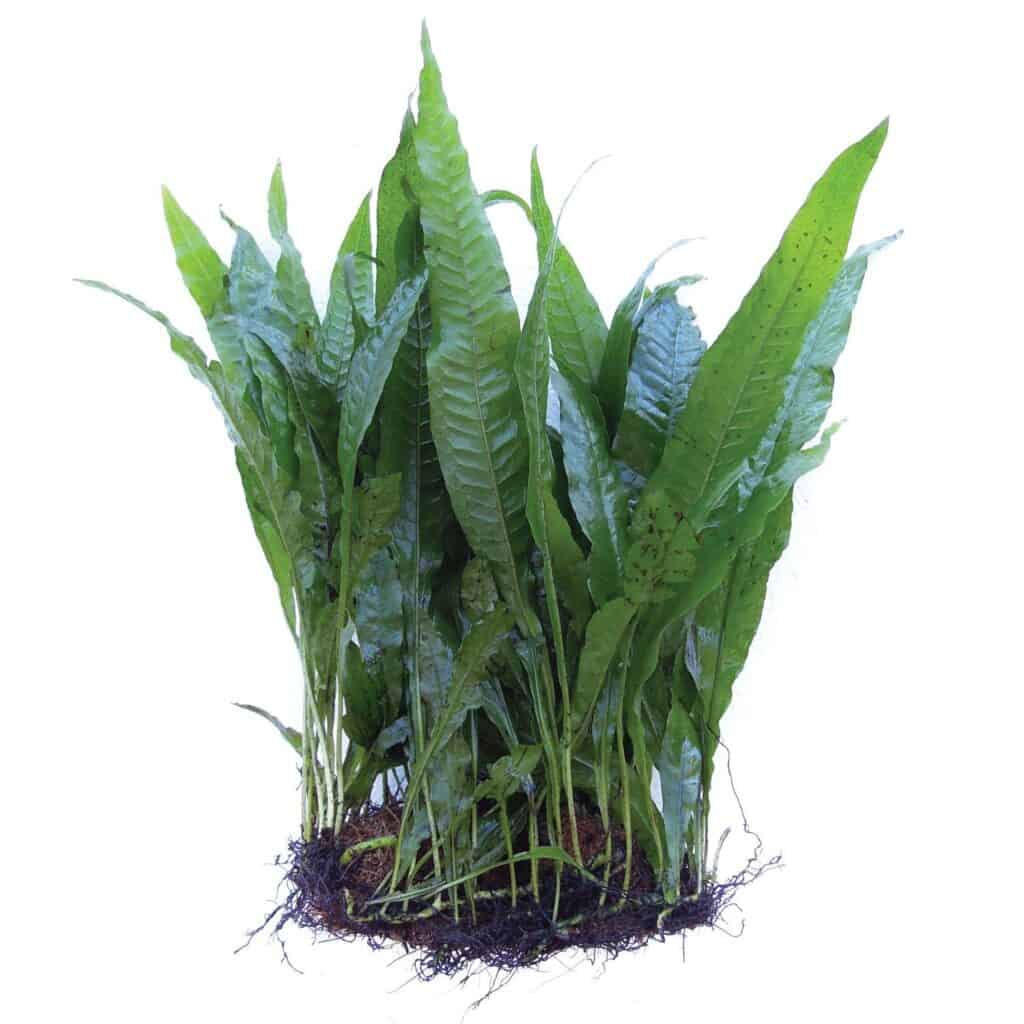
Java Fern, or Microsorum pteropus, is a hardy aquatic plant favored by many aquarium enthusiasts. We will cover its geographical origins, the optimal conditions it needs to thrive, and share key tips for its placement and care within an aquarium.
Origin and Species Variants
Microsorum pteropus, commonly known as the Java Fern, hails from the waterways of Southeast Asia. It’s a member of the Polypodiaceae family, adapting well to a wide range of aquatic environments. There are several variants of the Java Fern, each with unique characteristics:
- Trident: Known for multi-branching leaves with a trident-like shape.
- Windelov: Features intricately laced leaf tips.
- Narrow Leaf: Bears longer and slimmer leaves than the standard Java Fern.
- Needle Leaf: Has thin, needle-like leaves and a delicate appearance.
Optimal Growth Conditions
For Java Fern to thrive, certain conditions must be met. Here’s a table outlining these requirements:
| Water Parameter | Optimal Range |
|---|---|
| Temperature | 68-82°F (20-28°C) |
| pH | 6.0-7.5 |
| Lighting | Low to moderate |
| Water Hardness | 3-8 dKH |
Java Ferns are not demanding when it comes to lighting and can do well in low-light settings. They absorb nutrients through their leaves, so water containing a mild level of nutrients is sufficient for their growth.
Planting and Placement Tips
When planting Java Fern, we should keep in mind that its rhizome, the horizontal stem from which the leaves grow, should never be buried in the substrate. Instead, the Fern is best anchored to wood or rocks, which can be done using thread or fishing line until the plant naturally attaches itself. Over time, the plant will secure itself firmly to the surface using its roots.
In the aquarium, Java Fern can be positioned in the background or foreground, depending on the variant and the desired aesthetic effect. It can create a lush backdrop or serve as a focal point when attached to driftwood or a prominent rock formation. By avoiding substrate planting, we ensure the rhizome remains unrotted, allowing the Java Fern to flourish and become a resilient addition to the aquatic environment.
Maintenance and Care
Proper maintenance and care ensure the health and vigor of Java Fern, Microsorum pteropus. We’ll guide you through the optimal water conditions, necessary nutrients, and techniques to manage its growth.
Water Quality and Parameters
- Temperature: Keep water temperature between 68°F to 82°F (20°C to 28°C).
- pH Level: Maintain a pH level from 6.0 to 7.5.
- Water Hardness: Aim for a water hardness between 3 to 8 dKH (degrees of Carbonate Hardness).
- Nitrates: Ensure nitrates levels are low; not exceeding 10 ppm to prevent algae growth that competes with Java Fern.
- Oxygen: Good oxygenation is important; a well-functioning filter can aid in maintaining oxygen levels.
Nutrition and Fertilization
- Fertilizer: Use a liquid fertilizer sparingly as Java Fern is a light feeder.
- Iron and Potassium: Ensure the presence of iron and potassium which are crucial for Java Fern’s health.
- Nutrients: Provide nutrients through substrate or water-column feedings, especially if the plant shows signs of Java Fern melt or stunted growth.
Pruning and Managing Growth
- Pruning: Regularly trim old or damaged fronds to promote healthier growth.
- Growth: Allow room for expansion; Java Fern can grow quite large and overcrowding can lead to poor water conditions.
- Trimming: When trimming, use sharp scissors to make clean cuts; this prevents damage to the rhizome and reduces the risk of Java Fern melt.
Propagation and Reproduction
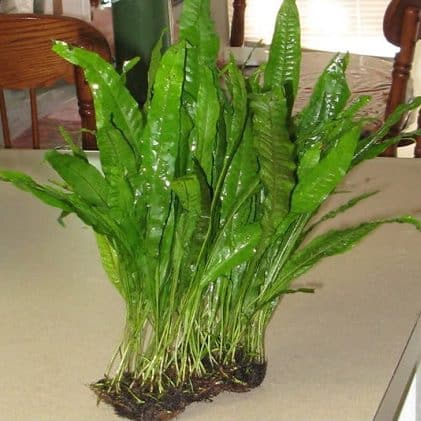
Java ferns are robust aquatic plants that propagate easily, making them a popular choice for aquascaping. Two main methods ensure their reproduction: the natural cycle and artificial techniques. We will guide you through understanding the fern’s natural reproductive process, methods to propagate it artificially, and solutions to common issues.
Natural Reproduction Cycle
Java ferns exhibit a unique reproductive cycle that does not depend on seeds. Instead, leaves develop small brown or black spots on their undersides, which are clusters of spores. These spots mature and release spores, which can settle onto surfaces and grow into new plants. This natural propagation aligns well with the plant’s slow growth rate, a characteristic trait of Java ferns.
Artificial Propagation Methods
When we want to encourage the proliferation of Java ferns in our aquascape, we use various artificial propagation methods to great effect.
Division of Rhizomes:
- Carefully cut the rhizome, which is the horizontal stem from which leaves grow, into sections.
- Ensure each section has at least a few leaves for photosynthesis and energy.
Plantlets:
- Java fern leaves sometimes produce plantlets along their edges.
- Once these plantlets develop roots, we can detach them and tie them to rocks or wood until they attach.
Table: Comparison of Propagation Methods
| Method | Advantages | Disadvantages |
|---|---|---|
| Division | – Quick increase in plant numbers – Easy to perform | – May stress the parent plant if done excessively |
| Plantlets | – Natural process – Minimal plant stress | – Takes longer to establish new plants |
Troubleshooting Common Issues
While propagating Java ferns, we might encounter issues such as disease, algae growth, or slow growth. Here’s how to address some of these challenges:
Algae: Algae often thrive on Java fern leaves when light levels are too high or water contains excess nutrients.
- Solution: Adjust light levels and nutrient input; remove affected leaves.
Disease: Brown spots on leaves might indicate disease rather than reproductive spores.
- Solution: Remove diseased leaves to prevent spread to new growth.
Slow Growth: Patience is key, as Java ferns are naturally slow-growing.
- Solution: Ensure appropriate water conditions and do not over-fertilize, as excess nutrients can hamper growth rate rather than enhance it.
By following these methods and solutions, we can effectively propagate and maintain healthy Java fern populations in our aquascapes.
Frequently Asked Questions
In this section, we address common queries regarding the care and variety of Java Fern, to ensure that your aquatic plant thrives in its environment.
How do you properly care for a Crested Java Fern?
To care for a Crested Java Fern, we recommend attaching it to driftwood or rocks instead of burying it in the substrate, as its rhizome needs to be exposed. We also advise consistent water conditions with a pH of 6.0 to 7.5 and a temperature range of 68-82°F.
What types of Java Fern are there besides the Narrow Leaf variety?
Besides the Narrow Leaf variety, there are several types of Java Fern including Trident, Windelov, and Needle Leaf. Each variety differs in leaf shape and size, offering a diverse range for aquascaping.
Is a high temperature suitable for growing Java Fern in an aquarium?
A high temperature is not ideal for Java Ferns; they prefer cooler water and can tolerate a range between 68-82°F. Ensuring the water is not too warm is key to preventing leaf damage and ensuring healthy growth.
What is the optimal lighting requirement for a Java Fern to thrive?
Java Fern requires low to medium lighting to thrive, with around 1.5 to 2 watts per gallon of water being sufficient. Too much light can cause algae to form on the leaves, so we aim for a balance that encourages growth without algae issues.
Where is the ideal placement for a Java Fern in an aquarium?
The ideal placement for a Java Fern in an aquarium is on driftwood or rocks towards the middle or background of the aquascape. They should be secured but not buried, allowing for adequate water flow around the rhizome.
Do Java Ferns require added CO2 to grow successfully?
Java Ferns do not require added CO2 to grow; they are quite adaptable and can thrive in low-tech setups. However, if we choose to add CO2, it should be regulated to avoid harming the plant and other aquarium inhabitants.
